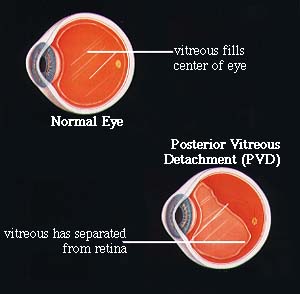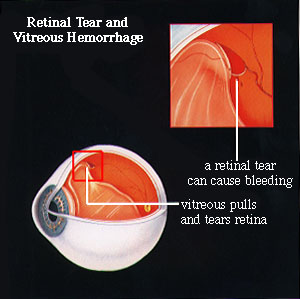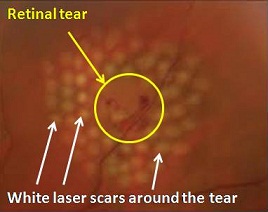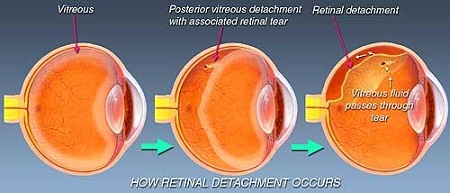
Posterior vitreous detachment, or PVD for short, is a degenerative change in the vitreous humor of the eye. It is very common and will occur in virtually everybody as age catches up. Most of the time, it occurs without causing any acute or long-term visual problems.
PVD is a natural change that occurs with age, usually starting from the age of 40. PVD happens in over 75% of those aged 65 or over. It is important to remember that PVD is not an ocular disease nor is it a sign of any impending eye health issue, unless it occurs at a relatively young age.
What is posterior vitreous detachment?
The vitreous humor is a transparent, gel-like substance that occupies entire back portion of the eyeball. This portion of the eye is called… (no prizes for guessing)… the vitreous cavity. At birth, the vitreous humor fills up the entire space in the cavity. With age, the vitreous degenerates and is no longer able to keep its original consistency and shape. When this happens, the vitreous shrinks and pulls away from the retina at the back wall of the eye. This separation of vitreous from retina is called posterior vitreous detachment.

Diagram demonstrating the separation of the back portion of the vitreous from the retina.
What are the symptoms?
The two main symptoms are flashing lights and floaters. Not everyone will experience both symptoms. You might experience one but not the other, or even no symptoms.
Flashing lights: The flashing lights you see from PVD are typically brief white or golden yellow streaks in the periphery of your vision. They are more obvious in the dark, and can be brought on by moving your eyes. These flashes occur due to stimulation of the retinal photoreceptors when the vitreous humor pulls away. As a result, the photoreceptors send multiple nerve impulses to your brain and you perceive multiple, short flashes of light.
Once the vitreous humor is fully detached from the retina, you should no longer see these flashing lights. This is because the vitreous will no longer be pulling on (and hence, stimulating) the retina. Sometimes, you may still notice an occasional flash of light – this is quite common and normal.
Floaters: Floaters can take on a variety of shapes and sizes. Typically, they are seen as dots, circles, lines, flies or cobwebs floating across your vision. Sometimes they are seen as moving around quickly when you shift your gaze, and sometimes no movement seems apparent. You may also notice a veil that comes in and out of your vision. Floaters may be more obvious in bright light.
You get floaters because the normal degenerative process of the vitreous humor creates debris or clumps of gel within the eyeball. The debris and clumps float in the vitreous cavity and catch light that enters the eye; the shadows that are cast on the retina are seen as floaters. Floaters are harmless and do not cause any longstanding eye problems. You can have floaters without having posterior vitreous detachment.
What complications can you get?
In the great majority of cases, the vitreous detaches without causing any problems. However, in up to 10%, vitreous detachment is accompanied by an ocular complication. The main complications are vitreous hemorrhage, retinal tear and retinal detachment.
Vitreous hemorrhage: Sometimes, detachment of the vitreous is accompanied by bleeding into the vitreous cavity. This is due to vitreous traction on a retinal blood vessel and bursting it as the vitreous detaches. The amount of bleeding can be mild (you see stringy floaters) or severe (your vision becomes completely obscured). If you have vitreous hemorrhage, your eye needs to be examined thoroughly for any signs of retinal tear or retinal detachment. If there is so much blood that precludes a proper examination, an ultrasound scan will need to be done. Usually the blood will clear over several months. Severe cases of bleeding will require vitrectomy surgery to remove the blood.

Diagram demonstrating how vitreous detachment can cause a retinal tear and hemorrhage
Retinal tear: Sometimes as the vitreous detaches, it tugs on the retina and causes the retina to tear or break. This is more likely if there are areas of weakness in your retina. If you have a retinal tear, you will need to have either laser or freezing treatment before the tear progresses to become a retinal detachment.

Retinal detachment: A retinal detachment occurs when the neurosensory retina peels away from the wall of the eye, much like when wallpaper peels away from the living room wall. Apart from flashes and floaters, you will also see a shadow or curtain in your field of vision. This is a sight-threatening condition and in most cases, will require retinal detachment surgery to restore vision.

Diagram demonstrating how detachment of the vitreous causes a retinal tear, which subsequently leads on to a retinal detachment.
It is not really possible to predict if you will develop problems as your vitreous detaches. What is known is that you are at higher risk of PVD-related complications if you have:
– A retinal tear or detachment in the other eye
– A family history of retinal tears or detachment
– Genetic disease such as Marfan syndrome and Stickler syndrome
– High myopia
Do you need to treat posterior vitreous detachment?
For most people, no treatment is required. The detached vitreous remains detached and does not re-attach again. PVD does not cause any permanent loss of vision. But a retinal detachment will. It is therefore very important that you consult your ophthalmologist as early as possible for a thorough dilated retinal examination if you experience the symptoms of flashes and floaters.
The flashes and floaters will eventually settle over several weeks to several months. Flashing lights tend to settle completely because the vitreous is no longer tugging on the retina.
Floaters will become less noticeable as your brain learns to adapt and to ignore them. However, they are unlikely to disappear completely. If you have a very annoying floater in the center of your vision, you may be able to displace it moving your eyes in a gentle circular motion. In some severe cases, laser or vitrectomy surgery may be appropriate. You may notice new floaters when new pockets of the vitreous degenerates. Don’t worry about these if you notice a few new floaters. If you notice a new shower of floaters, consult your ophthalmologist as soon as possible for a repeat retinal examination.
The associated complications of PVD tend to occur at the time the vitreous detaches. As such, it will be very unusual for the complications to occur some time later after the vitreous has detached. Nevertheless, it is always prudent to look out for the symptoms of retinal detachment. The earlier a detached retina is picked up and treated, the better the visual outcome.


